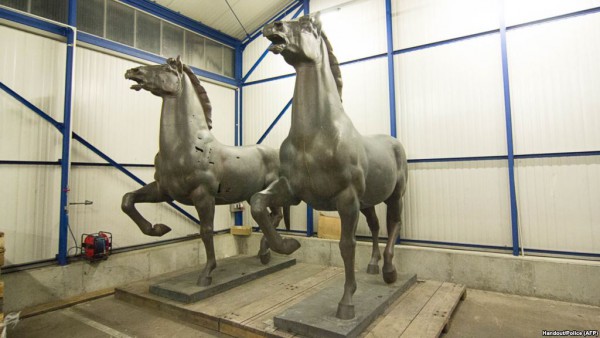Art & Exhibitions
Germany Debates What to Do With Nazi Art: Is It Time to Demystify Hitler’s Favorite Artists?
Should the artworks be shown publicly or kept hidden?

Should the artworks be shown publicly or kept hidden?

by
Henri Neuendorf

A week has passed since German police recovered a number of Nazi artworks in a major coordinated raid across several federal states.
Investigators found two massive bronze horse statues by Josef Thorak, sculptures by Fritz Klimsch and a large relief by Arno Breker among many other items, in a warehouse in the small town of Bad Dürkheim in Rheinland-Palatinate (see German Police Find Lost Hitler Horse Sculptures, Arrest Illegal Nazi-Art Dealers).
As a recent Wall Street Journal article point out, while the trade of Nazi-commissioned artworks in Germany is not illegal—as long as the works aren’t stolen or looted—the practice remains highly taboo.
Andreas Hüneke, an art historian at Berlin’s Free University said “It’s frowned upon because of [the artworks’] relationship with power.”
No respected, mainstream dealers or auction houses in Germany are prepared to risk being associated with Nazi art, irrespective of its merit. “All of us turn it down,” confirmed Henrik Hanstein, director of the Cologne-based auction house Kunsthaus Lempertz.
However, markets for fascist art, as well as for Nazi paraphernalia exist around the world. “There is a huge black market [for Nazi art and paraphernalia], especially in the US where you can buy and sell openly,” said Arthur Brand, whose company Artiaz specializes in investigating forgeries and looted art, and who helped German police track down the bronze horses.
In Germany the discovery has reignited a familiar debate. What to do with historically burdened art? Is it morally justifiable to show the works publicly?
According to a spokesperson for German Culture Minister Monika Grütters, if proven that the works belong to the state, the ministry advocates showing the recently rediscovered works in a museum to illustrate the Nazis’ utilization of art for propaganda purposes.
Art historian Christian Fuhrmeister from the Institute of Art History agrees. He told Deutsche Welle, “hiding it is no option.” He argues that the hidden fascinates the imagination and inspires myth. “What we need is a demystification, which came with the demonization.”
Munich’s Pinakothek for Modern Art is already contributing to this critical dialogue. A current exhibition titled “Contra(ry) Art: ‘Degenerate Art’ – Nazi Art – Collecting After ’45” displays works famously labelled by the Nazis as “degenerate” alongside examples of works commissioned by the national socialists themselves.
The museum’s statement is clear. Germany cannot engage with its history if the remnants of its past are stored away, out of sight.